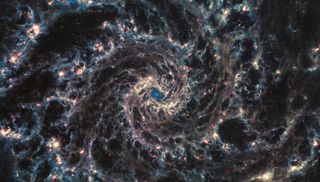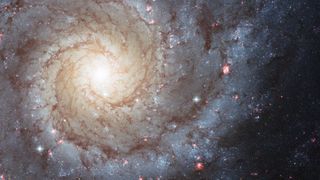James Webb Space Telescope's stunning 'Phantom Galaxy' picture looks like a wormhole
The telescope is 'new, different, and exciting' for Judy Schmidt, who has been working with space images for a decade.

A fresh image based on brand-new deep-space data appears to show a wormhole spinning before our very eyes.
The appropriately named "Phantom Galaxy" glows eerily in a new image by Judy Schmidt based on James Webb Space Telescope data collected nearly a million miles away from our planet using the observatory's mid-infrared instrument (MIRI).
"I've been doing this for 10 years now, and [Webb] data is new, different, and exciting," Schmidt told Space.com. "Of course I'm going to make something with it."
Live updates: NASA's James Webb Space Telescope mission
Gallery: James Webb Space Telescope's 1st photos
The image highlights the dust lanes in the galaxy, which is more properly known as NGC 628 or Messier 74. Dubbed the "perfect spiral" by some astronomers because the galaxy is so symmetrical, the Phantom Galaxy is scientifically interesting because of the intermediate-mass black hole scientists believe is embedded at its heart.
The galaxy has been imaged professionally many times before, including by space observatories such as the Hubble Space Telescope and the Wide-field Infrared Survey Explorer (WISE). What makes Webb imagery stand apart from these past efforts is the mid-infrared range that highlights cosmic dust, along with the power of its unique 18-segment hexagonal mirror and deep-space location.
Webb observed M74 earlier this week. The data was also shared on Twitter (with different filtration) by Gabriel Brammer, an astronomer at the Cosmic Dawn Center in the Niels Bohr Institute at the University of Denmark.
Get the Space.com Newsletter
Breaking space news, the latest updates on rocket launches, skywatching events and more!
A selected of raw Webb imagery is made publicly available at this portal a few hours or days after observations, and amateur imagers and scientists are free to use the data as long as they credit the source when publishing.

The busy deep-space telescope released its first operational images on July 12 of deep-space objects, including a nebula and a view of very young galaxies. An infrared view of Jupiter, along with the gas giant's moons and rings, joined the iconic new images on July 14.
That week's work alone showcases Webb's flexibility in switching between faraway objects near the cosmic dawn — when stars began shining — and solar system objects much closer to its viewfinder.
As for the Phantom Galaxy, Schmidt used Photoshop and FITS Liberator for most of the work and said many of the concepts in her 2017 YouTube imaging tutorial will help with the more advanced software of today.
You can check out more spectacular imagery of Webb photos and other cosmic objects at Schmidt's Flickr page.
Follow Elizabeth Howell on Twitter @howellspace. Follow us on Twitter @Spacedotcom and on Facebook.
Join our Space Forums to keep talking space on the latest missions, night sky and more! And if you have a news tip, correction or comment, let us know at: community@space.com.

Elizabeth Howell (she/her), Ph.D., is a staff writer in the spaceflight channel since 2022 covering diversity, education and gaming as well. She was contributing writer for Space.com for 10 years before joining full-time. Elizabeth's reporting includes multiple exclusives with the White House and Office of the Vice-President of the United States, an exclusive conversation with aspiring space tourist (and NSYNC bassist) Lance Bass, speaking several times with the International Space Station, witnessing five human spaceflight launches on two continents, flying parabolic, working inside a spacesuit, and participating in a simulated Mars mission. Her latest book, "Why Am I Taller?", is co-written with astronaut Dave Williams. Elizabeth holds a Ph.D. and M.Sc. in Space Studies from the University of North Dakota, a Bachelor of Journalism from Canada's Carleton University and a Bachelor of History from Canada's Athabasca University. Elizabeth is also a post-secondary instructor in communications and science at several institutions since 2015; her experience includes developing and teaching an astronomy course at Canada's Algonquin College (with Indigenous content as well) to more than 1,000 students since 2020. Elizabeth first got interested in space after watching the movie Apollo 13 in 1996, and still wants to be an astronaut someday. Mastodon: https://qoto.org/@howellspace
